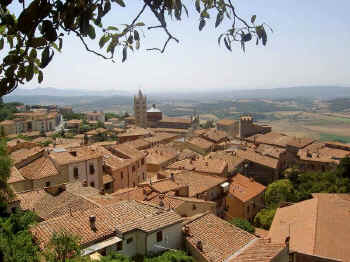
|
Massa Marittima |
Massa Marittima - location and districtsMassa Marittima is situated in the Maremma of Tuscany, Italy - specifically, the inland hills of the Alta or northern Maremma - 51 km north of Grosseto. Despite its name is some distance from the sea and in fact "marittima" does not allude to the sea but rather to the Maremma. Massa Marittima was founded by the Etruscans, like many cities in Tuscany, and is located in the Colline Metallifere so that its history is closely linked to the copper and silver mines nearby. The city can be divided into three distinct areas, la Citta Vecchia (old city), la CittÓ Nuova (new city) and the Borgo. Each area is architecturally distinct and among the sights to be seen are Piazza Garibaldi, Il Duomo, Palazzo Pretorio and the Palazzo Communale. There is also a museum of mining which is partly housed in a disused mine shaft. Massa is the birthplace of the family Albizzeschi, San Bernardino da Siena (1380-1444). Prata and the castles of Perolla and Tatti are also of historic interest. Massa Marittima is a CittÓ Slow - a "slow town" of Italy Massa Marittima - architectureThe mediaeval centre of the town is well preserved, with the gorgeous Duomo, the Palazzo Pretorio, Palazzo Comunale, the Church of Sant' Agostino and the Fonte dell' Abbondanza. It is considered one of the mediaeval jewels of Tuscany. |
● Duomo of Massa MarittimaIt emerges at the top of a flight of steps in the beautiful Piazza Garibaldi, heart and focal point of the mediaeval city. Built in the 13 C in Romanesque-Gothic style, of note is the beautiful fašade with arches and small loggias surmounted by pinnacles. The pointed bell tower is characterised by a series of fine four-light windows. The three naved interior preserves notable works of art such as the 14 C travertine baptismal font, a 13 C crucifix and the "Madonna delle Grazie" 14 C, attributed to Duccio di Buoninsegna. The Duomo also preserves the "NativitÓ" by Rutilio Manetti and on the high altar, the marble sculpture "Arca di San Cerbone", a masterpiece of Siennese school. ● Palazzo Pretorio at Massa Marittima13th century building with an elegant fašade adorned by mullioned windows and coats of arms. It houses the "Archaeological Museum" with many Roman and Etruscan finds and the "Pinacoteca" picture gallery where the "MaestÓ" by Ambrogio Lorenzetti and some works by Sassetta and Sano di Pietro are on display. ● Palazzo Comunale Massa MarittimaRomanesque building in the 13 C, created by the merging of three tower-houses. ● Church of Sant' Agostino at Massa MarittimaBuilt in Gothic style, the church has a travertine Romanesque fašade with portal, rose window and semi-octagonal abside with arches. Inside are works by Lorenzo Lippi and Rutilio Manetti. More abut the Church and Cloister of Saint Augustine at Massa Marittima. ● Fonte dell' Abbondanza at Massa Marittimaattractive covered spring (click the picture for a larger view) ● Mining museum at Massa Marittimaconsists in a series of underground tunnels recalling the real environment of the mine, with an exhibition of instruments and machinery, as well as a rich collection of stones and ores from the surrounding mining area.
Balestro del Girifalco of Massa MarittimaThe "Balestro del Girifalco" has taken place since ancient times, twice a year
on the first Sunday after May 20 and the 2nd Sunday of August. The
Balestro is a crossbow competition between the quarters of the city, named "
Terzieri", which consists of hitting the target placed at a distance of 36 meters from the start. Each crossbowman, 24 maximum, shoots an arrow. The crossbowman who is able to put the arrow nearest the target centre is the winner. A gold arrow made by an artist, is the prize for the winning arbalester, whereas, the winning quarter receives the
"Palio", a painted silk cloth. About 200 people in mediaeval costumes take part in this
pageant. > > > Click the small pictures for a larger view < < < |
|||
History of Massa Marittima (Massana)
Massa Marittima, in the Province of Grosseto, in Tuscany, was first mentioned in the
8 C. It grew at the expense of
Populonia, an ancient city of the Etruscans, where numerous
Etruscan ruins may be viewed today. Populonia was important on account of its iron,
tin and copper works. It was besieged by Sulla, and in Strabo's time was already
in decline and later it suffered at the hands of Totila, of the Lombards, and in 817, of a Byzantine fleet. After this, the bishops of Populonia abandoned the town, and in the eleventh century, established their residence at Massa. In 1226 Massa became a commune under the protection of Pisa. In 1307 it made an alliance with Siena, which was the cause of many wars between the two republics that brought about the
downfall of Massa as an economic centre. Click here for a more detailed history of Massa Marittima
Maps of Massa Marittima |
Web design, hosting, content management by ammonet
Massa Marittima ę ammonet InfoTech 2000 - 2020. All rights reserved.